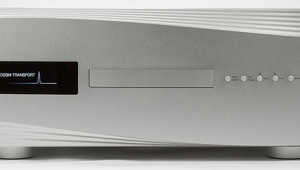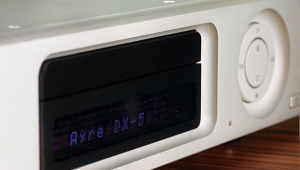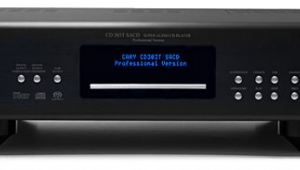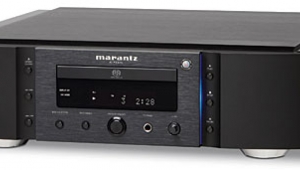| Columns Retired Columns & Blogs |
Sony SCD-1 Super Audio CD/CD player Page 5
Telling Sonic Event No.2 revolved around Kavi Alexander's fantastic recording, Nature's Realm (Water Lily Acoustics WLA-WS-66-SACD), with Wolfgang Sawallisch and the Philadelphia Orchestra playing Liszt's Les Préludes and three concert overtures by Dvorák. The music is inspiring, even if the hall wasn't perfectly suited to the performance. But if you don't hear a subway rumbling through the recording near the beginning and from time to time during the performance, you're not getting deep bass from your system. What's that got to do with the music? Not much, but the ability to render that which lies below helps define the space and fill it out acoustically. In this respect, the Sony was a fabulous performer.
Transient information in the bass is often characterized in a rather two-dimensional way, usually as a leading-edge event with follow-on harmonic development and bloom ebbing into the noise floor. On the Sony, especially into the Burmester/Linn Klimax Solos, the leading edge of the bass was more complex and rich in information than I'd ever heard before, like the late-afternoon sun illuminating the foam at the tip of a breaking wave roiling with energy—or, in the acoustic sense, information. That's certainly one way in which the SCD-1 distinguished itself in our system, and certainly how it managed to sound so powerfully impactful on mighty bass blasts.
And it was largely due to the DSD process's immense transparency and clarity that these fulsome effects in the bass were so apparent. Midbass, and especially the upper midbass—again, especially on the Burmester/Klimax combo—proved incredibly transparent, taut, and, yet again, redolent with detail and information. A delicious luminosity in the mids and upper midrange brought vocals to life, and the highs were very open, a quality I much prize.
I then spun Telarc's SACD sampler (SACD-99-1). Only Dvorák's Stabat Mater saves this disc from irrelevance, I'm sorry to say. But the Dvorák is a monumental work monumentally recorded [the CD is this issue's "Recording of the Month"—Ed.]. The choir and orchestra all take a deep breath and belt it out in a perfectly astounding and fabulously involving way. The air, space, and separation of each element were truly inspiring. The quality and integrity of massed vocals stunned me into silence in the Ribbon Chair. I was struck again, as during the Steve Davis tracks, by an altogether special sense of sonic continuity that welled down into and through what seemed like the molecular level of the sound.
There's an undeniable sense of liquidity and smoothness with SACDs—"perfectly connecting the dots," as I scribbled late one night. Of course, in a real sense, there are no dots to connect, as there's no decimation (or subsequent reconstruction) of the waveform in the DSD process. Its signal represents an analog of the waveform at the 1-bit level at a very high sampling rate.
When I've written about liquidity before, it's most often been in reference to tubes. When done right—ie, working within the tubes' linear range—the physics of electrons flowing through control grids in a vacuum creates something of that same connectivity and wholeness in reproduced sound that the Sony seems to so effortlessly provide. Playing the Telarc Stabat Mater in both modes, it was apparent that SACD is superior to CD in terms of roundness, imaging, tonality, fullness, harmonics, air, space, focus palpability, quiet between the notes, pace...in a word, everything! There's not a thing it doesn't do better, and by a significant degree.
The breathtaking liquidity of which I speak is in no small part enabled by the quality and utter clarity of the acoustic decay blooming out and down into a very quiet noise floor in a wholly natural fashion. A key element of SACD's sound was its handling of acoustic decay, which was always very well developed and very available to me in the Ribbon Chair. My listening notes also go on at length about dynamics, which were magnificent, along with the nuanced shadings and elegant turns of low-level information that work so much better in DSD than in 16/44.1 PCM. As the massed voices at full throttle in Stabat Mater bulged the walls of our loft, the sound remained so organic, so real, and so very awesome, even for one as jaded as I. It truly felt as if I was there.
Back in Nature's Realm, I tapped out: "As the waves crash ashore in the Liszt, it occurs to me how fundamentally right the SCD-1's sound is. The huge and colorful transients are lovely in their grandeur—nothing out of shape or edgy, everything in its musical place." I got quite involved listening to an SACD test pressing of Jon Hassell's Fascinoma. The CD (Water Lily Acoustics WLA-CS-70-CD) is one of my favorites of late. I mention it for its wonderful, airy, spacious, and liquid soundstage, the amazing palpability, the sweet and dulcet tones, the very sensitivity of the music that seemed to arrive wholly unimpeded at the listening chair.
AudioQuest Music's BluesQuest SACD sampler was another of my favorite SACD recordings. Joe Beard was soulful beyond words, and Sam McClain doing "Too Proud" was just too killer!—the powerful and fulsome bass, the sparkling, lightning-quick top end, a midrange full of texture and flavor, and Sam's voice so smooth and palpable, hanging there between the Utopias. It was wonderful. That Sam sings this number a little in his throat, as it were, is so evident via the SACD. Talk about openness, clarity, and nuance—top drawer in every way.
- Log in or register to post comments




































